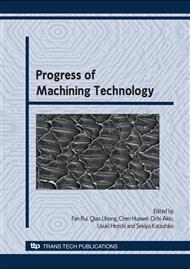p.376
p.380
p.384
p.388
p.395
p.400
p.404
p.408
p.412
The Investigation of Tool Wear in Metal Machining Using Finite Element Method
Abstract:
The existing studies based on 2-dimension cutting model are partial investigations on tool wear. In order to get close to the true cutting conditions, the Lagrangian thermo-viscoplastic cutting simulations were conducted and the tool wears were predicted under different cutting speeds using 3-dimension finite element models. The simulation results indicate that when the cutting speed increases the cutting forces will reduce accordingly while the wear depth will be deeper. As a result, different factors should be considered at the same time when the speed range is selected. This study has shown that the finite element method is a valuable approach to understand the tool wear mechanism in machining and the influences of different cutting speeds.
Info:
Periodical:
Pages:
395-399
Citation:
Online since:
February 2009
Authors:
Keywords:
Price:
Сopyright:
© 2009 Trans Tech Publications Ltd. All Rights Reserved
Share:
Citation:


